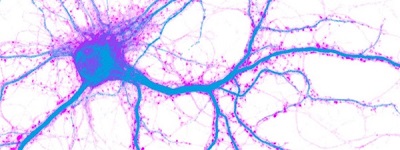News Archive
Location matters: The production site predicts protein abundance
July 2019. Proteins are the building blocks of life, and neurons in the brain need a steady supply of proteins to remain functional. The long processes of a neuron that receive information from other neurons are called dendrites. Dendrites are home to thousands of different kinds of proteins, and each is needed in a particular amount at a particular place. Scientists at the Max Planck Institute (MPI) for Brain Research in Frankfurt developed a mathematical model that can reliably predict the density and dynamics of dendritic proteins. Their results reveal that the localization of mRNAs, the precursor molecules of proteins, from the cell body into the distal dendrites allocates more proteins to these remote regions and accelerates the protein response dynamics to inputs.
 Neurons consist of a cell body called the soma, where the genetic information of the cell is stored, and from which multiple dendrites branch off. The communication between neurons is mediated by synapses which change their protein concentration when neurons store information. Synapses are distributed throughout the dendritic tree, up to hundreds of microns away from the soma. A neuron must be able to increase the number of specific proteins at stimulated synapses quickly to store information. “The challenge is that synapses, especially the ones that have just undergone learning, need extra proteins to be readily available. Fast production and efficient transport to the synapses are therefore a must. However, if proteins are only made in the soma they might be degraded before ever reaching their destination”, agree Yombe Fonkeu, Nataliya Kraynyukova, and Anne-Sophie Hafner, the three co-first authors of the new study by the MPI’s Tchumatchenko and Schuman labs research published in the 23 July issue of the journal Neuron. This creates a conundrum since cells need to produce proteins on-demand, but the demand location often changes, and the transport of proteins can be too slow to catch up.
Neurons consist of a cell body called the soma, where the genetic information of the cell is stored, and from which multiple dendrites branch off. The communication between neurons is mediated by synapses which change their protein concentration when neurons store information. Synapses are distributed throughout the dendritic tree, up to hundreds of microns away from the soma. A neuron must be able to increase the number of specific proteins at stimulated synapses quickly to store information. “The challenge is that synapses, especially the ones that have just undergone learning, need extra proteins to be readily available. Fast production and efficient transport to the synapses are therefore a must. However, if proteins are only made in the soma they might be degraded before ever reaching their destination”, agree Yombe Fonkeu, Nataliya Kraynyukova, and Anne-Sophie Hafner, the three co-first authors of the new study by the MPI’s Tchumatchenko and Schuman labs research published in the 23 July issue of the journal Neuron. This creates a conundrum since cells need to produce proteins on-demand, but the demand location often changes, and the transport of proteins can be too slow to catch up.
Work over the past 25 years has shown mRNA molecules are not only present in the cell body, but also available in the dendrites where they serve as the template for proteins to be made. This allows neurons to quickly produce proteins directly from the local mRNA at stimulated synapses. The scientists were facing a big challenge. “Quantifying just how many mRNAs leave the soma and how many remain behind has not been straightforward,” points out Erin Schuman. The interdisciplinary team of scientists addressed this challenge by building a dynamic mathematical model of the dendritic distribution of mRNA and their corresponding proteins.
The model, which the scientists validated with experimental data, was able to couple the production, transport and degradation of new proteins to their mRNAs in both the soma and the dendrites. “We found that the dendritic localization profile of mRNA and their motion features affect protein abundance. This lets us see the protein dynamics in response to synaptic plasticity in a new, quantitative way,” says Tchumatchenko. Insights like these from the mathematical model could shape the kind of information collected in future experiments.
To predict the dynamics for proteins of interest, the team created a web application inviting users from around the world to explore the specific dynamics of their proteins of interest. “This opens the door to further research on how protein production underlies synaptic plasticity. Our model is an important step in understanding protein synthesis and transportation in the brain. Moreover, we hope that it serves as a catalyst for future interdisciplinary collaborations that tackle currently unsolved questions and opens new avenues for addressing neurological diseases”, Tchumatchenko says.
The work was funded by the Max Planck Society and the DFG (CRC 1080). The project has received additional funding by grants from the European Research Council (ERC) under the European Union’s Horizon 2020 research and innovation program, EMBO and the Alexander von Humboldt Foundation.
Contact:
Irina Epstein, Press and Public Relations, Max Planck Institute for Brain Research, Frankfurt am Main, Irina.Epstein@brain.mpg.de
Reference:
Yombe Fonkeu#, Nataliya Kraynyukova#, Anne-Sophie Hafner#, Lisa Kochen, Fabio Sartori, Erin M. Schuman, Tatjana Tchumatchenko* (2019) How mRNA Localization and Protein Synthesis Sites Influence Dendritic Protein Distribution and Dynamics, Neuron, published online 23 July 2019 . *Equal contribution. DOI: https://doi.org/10.1016/j.neuron.2019.06.022 (link)

